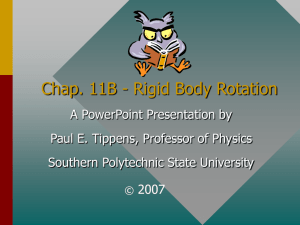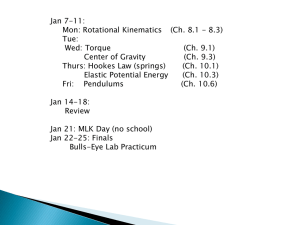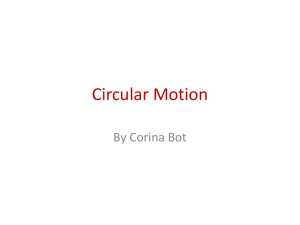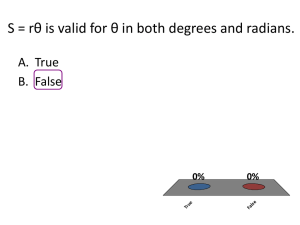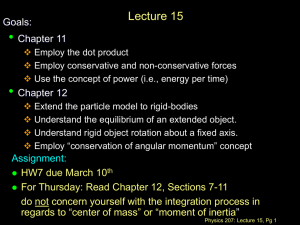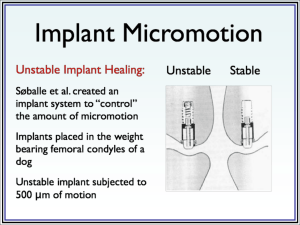Rigid Body Rotation
advertisement
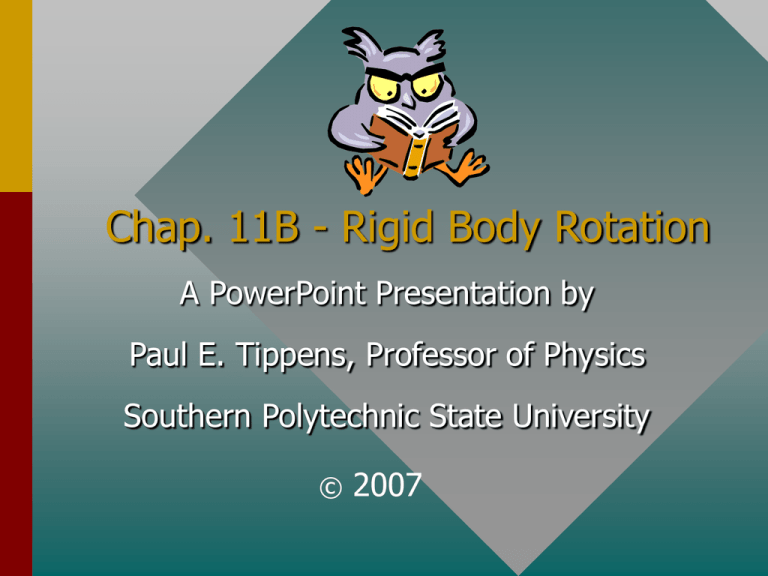
Chap. 11B - Rigid Body Rotation A PowerPoint Presentation by Paul E. Tippens, Professor of Physics Southern Polytechnic State University © 2007 Objectives: After completing this module, you should be able to: • Define and calculate the moment of inertia for simple systems. • Define and apply the concepts of Newton’s second law, rotational kinetic energy, rotational work, rotational power, and rotational momentum to the solution of physical problems. • Apply principles of conservation of energy and momentum to problems involving rotation of rigid bodies. Inertia of Rotation Consider Newton’s second law for the inertia of rotation to be patterned after the law for translation. F = 20 N a = 4 m/s2 F = 20 N R = 0.5 m a = 2 rad/s2 Linear Inertia, m 24 N m = 4 m/s2 = 5 kg Rotational Inertia, I t (20 N)(0.5 m) 2 I=a = = 2.5 kg m 4 m/s2 Force does for translation what torque does for rotation: Rotational Kinetic Energy Consider tiny mass m: K = ½mv2 K = ½m(wR)2 K= ½(mR2)w2 Sum to find K total: K = ½(SmR2)w2 (½w2 same for all m ) v = wR m w m1 axis m 4 m3 m2 Object rotating at constant w. Rotational Inertia Defined: I = SmR2 Example 1: What is the rotational kinetic energy of the device shown if it rotates at a constant speed of 600 rpm? First: I = SmR2 m)2 I = (3 kg)(1 + (2 kg)(3 m)2 + (1 kg)(2 m)2 I = 25 kg m2 2 kg 3m 3 kg 1m 2m w 1 kg w = 600 rpm = 62.8 rad/s K = ½Iw2 = ½(25 kg m2)(62.8 rad/s) 2 K = 49,300 J Common Rotational Inertias L L I I= 1 I 2 3 mL R R mR2 ½mR2 Hoop I= Disk or cylinder 1 12 2 mL R I 2 5 mR Solid sphere 2 Example 2: A circular hoop and a disk each have a mass of 3 kg and a radius of 30 cm. Compare their rotational inertias. I mR (3 kg)(0.2 m) 2 2 I = 0.120 kg m2 R I = ½mR2 Disk R I = mR2 Hoop I 12 mR2 12 (3 kg)(0.2 m)2 I = 0.0600 kg m2 Important Analogies For many problems involving rotation, there is an analogy to be drawn from linear motion. x m f t I R 4 kg A resultant force F produces negative acceleration a for a mass m. F ma w w 50 rad/s o t = 40 N m A resultant torque t produces angular acceleration a of disk with rotational inertia I. t Ia Newton’s 2nd Law for Rotation How many revolutions required to stop? t = Ia FR = (½mR2)a 2F 2(40N) a mR (4 kg)(0.2 m) a = 100 rad/s2 F R 4 kg w wo 50 rad/s R = 0.20 m F = 40 N 0 2aq wf2 - wo2 w02 (50 rad/s)2 q 2a 2(100 rad/s2 ) q = 12.5 rad = 1.99 rev Example 3: What is the linear acceleration of the falling 2-kg mass? Apply Newton’s 2nd law to rotating disk: TR = t Ia T = ½MRa M 6 kg a=? 2 kg a a = aR; a = but R a T = ½MR( ) ; R (½MR2)a R = 50 cm and T = ½Ma R = 50 cm 6 kg Apply Newton’s 2nd law to falling mass: mg - T = ma mg - ½Ma T = ma T +a (2 kg)(9.8 m/s2) - ½(6 kg) a = (2 kg) a 19.6 N - (3 kg) a = (2 kg) a T a = 3.92 m/s2 2 kg mg Work and Power for Rotation Work = Fs = FRq t FR q Work = tq tq Work Power = = t t s q w= t F F s = Rq Power = t w Power = Torque x average angular velocity Example 4: The rotating disk has a radius of 40 cm and a mass of 6 kg. Find the work and power if the 2-kg mass is lifted 20 m in 4 s. Work = tq = FR q s 20 m q= = = 50 rad R 0.4 m q 2 kg 6 kg Power = Work = 392 J t 4s F F=W s = 20 m F = mg = (2 kg)(9.8 m/s2); F = 19.6 N Work = (19.6 N)(0.4 m)(50 rad) s Work = 392 J Power = 98 W The Work-Energy Theorem Recall for linear motion that the work done is equal to the change in linear kinetic energy: Fx ½mv ½mv 2 f 2 0 Using angular analogies, we find the rotational work is equal to the change in rotational kinetic energy: tq ½Iw ½Iw 2 f 2 0 Applying the Work-Energy Theorem: F What work is needed to stop wheel rotating: R Work = DKr 4 kg w wo 60 rad/s R = 0.30 m F = 40 N First find I for wheel: I = mR2 = (4 kg)(0.3 m)2 = 0.36 kg m2 0 tq ½Iw ½Iw 2 f 2 0 Work = -½Iwo2 Work = -½(0.36 kg m2)(60 rad/s)2 Work = -648 J Combined Rotation and Translation vcm vcm vcm First consider a disk sliding without friction. The velocity of any part is equal to velocity vcm of the center of mass. w Now consider a ball rolling without slipping. The angular velocity w about the point P is same as w for disk, so that we write: v w R Or v R P v wR Two Kinds of Kinetic Energy Kinetic Energy of Translation: Kinetic Energy of Rotation: K= w ½mv2 v R P K = ½Iw2 Total Kinetic Energy of a Rolling Object: KT mv Iw 1 2 2 1 2 2 Angular/Linear Conversions In many applications, you must solve an equation with both angular and linear parameters. It is necessary to remember the bridges: s qR s q R Velocity: v wR Acceleration: v aR v w R a a R Displacement: Translation or Rotation? If you are to solve for a linear parameter, you must convert all angular terms to linear terms: s q R v w R a a R I (?)mR 2 If you are to solve for an angular parameter, you must convert all linear terms to angular terms: s qR v wR v aR Example (a): Find velocity v of a disk if given its total kinetic energy E. Total energy: E = ½mv2 + ½Iw2 v E mv I w ; I mR ; w R 1 2 2 1 2 2 2 1 2 2 v 2 2 1 1 1 E 2 mv 2 2 mR 2 ; R 3mv 2 E 4 or E 12 mv 2 14 mv 2 4E v 3m Example (b) Find angular velocity w of a disk given its total kinetic energy E. Total energy: E = ½mv2 + ½Iw2 E 12 mv2 12 Iw2 ; I 12 mR2 ; v wR E 12 m(w R) 2 12 12 mR 2 w 2 ; E 12 mR 2w 2 14 mR 2w 2 3mR 2w 2 E 4 or 4E w 3mR 2 Strategy for Problems • Draw and label a sketch of the problem. • List givens and state what is to be found. • Write formulas for finding the moments of inertia for each body that is in rotation. • Recall concepts involved (power, energy, work, conservation, etc.) and write an equation involving the unknown quantity. • Solve for the unknown quantity. Example 5: A circular hoop and a circular disk, each of the same mass and radius, roll at a linear speed v. Compare the kinetic energies. w w Two kinds of energy: KT = ½mv2 v Kr = ½Iw2 Total energy: E = ½mv2 + ½Iw2 2 v 2 2 Disk: E ½mv ½ ½mR 2 R 2 v 2 2 Hoop: E ½mv ½ mR 2 R v w= R E = ¾mv2 E = mv2 v Conservation of Energy The total energy is still conserved for systems in rotation and translation. However, rotation must now be considered. Begin: (U + Kt + KR)o = End: (U + Kt + KR)f Height? mgho Rotation? ½Iwo2 velocity? ½mvo2 = mghf Height? ½Iwf2 Rotation? ½mvf2 velocity? Example 6: Find the velocity of the 2-kg mass just before it strikes the floor. R = 50 cm mgho mghf = ½Iwo2 ½Iwf2 ½mvf2 ½mvo2 mgh0 12 mv2 12 Iw 2 (2)(9.8)(10) (2)v (6)v 2 2 kg h = 10 m I 12 MR2 2 v 2 2 1 1 1 mgh0 2 mv 2 ( 2 MR ) 2 R 1 2 6 kg 1 4 2 2.5v2 = 196 m2/s2 v = 8.85 m/s Example 7: A hoop and a disk roll from the top of an incline. What are their speeds at the bottom if the initial height is 20 m? mgho = ½mv2 + ½Iw2 Hoop: I = mR2 2 v 2 2 mgh0 ½ mv ½(mR ) 2 R 20 m mgho = ½mv2 + ½mv2; mgho = mv2 v gh0 (9.8 m/s 2 )(20 m) Hoop: Disk: I = ½mR2; mgho = ½mv2 + ½Iw2 2 v 2 2 mgh0 ½ mv ½(½ mR ) 2 R v = 14 m/s v 4 3 gh0 v = 16.2 m/s Angular Momentum Defined Consider a particle m moving with velocity v in a circle of radius r. Define angular momentum L: L = mvr Substituting v= wr, gives: L = m(wr) r = mr2w For extended rotating body: L = (Smr2) w v = wr m w m1 axis m 4 m3 m2 Object rotating at constant w. Since I = Smr2, we have: L = Iw Angular Momentum Example 8: Find the angular momentum of a thin 4-kg rod of length 2 m if it rotates about its midpoint at a speed of 300 rpm. 1 For rod: I = 12mL2 = 1 (4 12 kg)(2 m)2 L=2m m = 4 kg I = 1.33 kg m2 rev 2 rad 1 min w 300 31.4 rad/s min 1 rev 60 s L = Iw (1.33 kg m2)(31.4 rad/s)2 L = 1315 kg m2/s Impulse and Momentum Recall for linear motion the linear impulse is equal to the change in linear momentum: F Dt mv f mv0 Using angular analogies, we find angular impulse to be equal to the change in angular momentum: t Dt Iw f Iw0 Example 9: A sharp force of 200 N is applied to the edge of a wheel free to rotate. The force acts for 0.002 s. What is the final angular velocity? I = mR2 = (2 kg)(0.4 m)2 I = 0.32 kg m2 Applied torque t FR D t = 0.002 s w 0 rad/s w o R R = 0.40 m F 2 kg F = 200 N Impulse = change in angular momentum 0 t Dt = Iwf Iwo FR Dt = Iwf wf = 0.5 rad/s Conservation of Momentum In the absence of external torque the rotational momentum of a system is conserved (constant). 0 Ifwf Iowo = t Dt Ifwf Iowo Io = 2 kg m2; wo = 600 rpm I0w0 (2 kg m2 )(600 rpm) wf If 6 kg m2 If = 6 kg m2; wo = ? wf = 200 rpm Summary – Rotational Analogies Quantity Linear Rotational Displacement Displacement x Radians q Inertia Mass (kg) I (kgm2) Force Newtons N Torque N·m Velocity v “ m/s ” w Rad/s Acceleration a “ m/s2 ” a Rad/s2 Momentum mv (kg m/s) Iw (kgm2rad/s) Analogous Formulas Linear Motion Rotational Motion F = ma K = ½mv2 Work = Fx t = Ia K = ½Iw2 Work = tq Power = Fv Power = Iw Fx = ½mvf2 - ½mvo2 tq = ½Iwf2 - ½Iwo2 Summary of Formulas: K Iw 1 2 Work tq 2 tq ½Iw ½Iw 2 f Height? mgho Rotation? ½Iwo2 velocity? ½mvo2 2 0 = I = SmR2 Iowo I f w f Power tq t tw mghf Height? ½Iwf2 Rotation? ½mvf2 velocity? CONCLUSION: Chapter 11B Rigid Body Rotation
